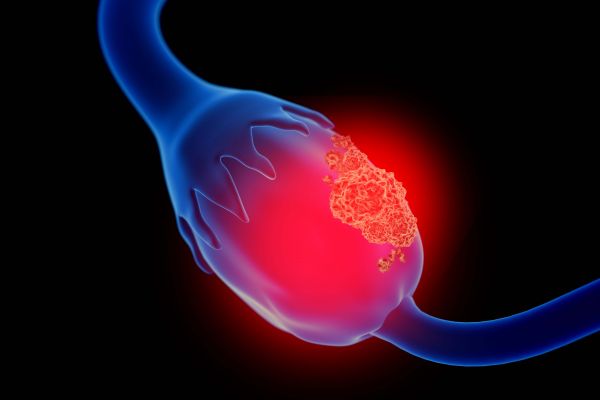“The short answer is yes,” says gynecologic oncologist Peter Frederick, MD, FACOG, Associate Professor and Clinical Chief of Gynecology at Roswell Park. “What matters most in terms of whether ovarian cancer will recur is the stage of disease at the time of diagnosis and if all visible cancer was removed at the time of surgery. A patient’s age and overall health, as well as the specific subtype of ovarian cancer, are also important in determining recurrence risk. Other factors can be more difficult to predict, such as the cancer’s sensitivity to treatments such as chemotherapy.”
This can be confusing, because many people think a hysterectomy removes all the reproductive organs. Technically, hysterectomy means removing only the uterus (or womb), leaving the ovaries and fallopian tubes in place. Even a total hysterectomy removes only the uterus and the cervix, which by itself is not a treatment for ovarian cancer. The ovaries are separate structures, and the surgery to remove ovaries is called an oophorectomy. If the fallopian tubes are removed along with the ovaries, the procedure is called salpingo-oophorectomy.
For women diagnosed with ovarian cancer, the standard surgery includes removal of the uterus, cervix, ovaries and fallopian tubes. Sometimes the uterus and one ovary or part of an ovary may be spared, an option used in specific cases — for example, in young women with early-stage ovarian cancer who wish to retain fertility and hormonal function. “The surgical approach and extent of surgery can often be uniquely tailored, depending on a patient’s individual circumstances,” says Dr. Frederick. “I would encourage patients to have these discussions with their cancer surgeon prior to surgery.”
If ovarian cancer does return after surgery, most commonly it will recur in the peritoneal cavity, the space below the diaphragm that includes the abdominal and pelvic structures. “Often we will monitor for recurrence with a combination of tumor markers such as CA-125, physical examination — monitoring for signs and symptoms, such as abdominal bloating or pelvic pain — and, in some cases, imaging tests, such as CT scans.”
Stage at Diagnosis Most Important
Overall, 80% of patients with early-stage ovarian cancer are free of disease at five years, but there is a tremendous difference in the recurrence rate based on the stage of the disease at the time of diagnosis. Like many solid tumor cancers, ovarian cancer is classified into four main stages. With stage 1 cancer, in which cancer cells are confined to one or both ovaries, the risk for recurrence is low, about 10%. As a result, five-year survival is around 90%. Unfortunately, only a small number of women have their cancers diagnosed at this early stage.
“You can see recurrence at any stage,” says Dr. Frederick. “But the more advanced the disease is at diagnosis, the greater the risk for recurrence.” With stage 2 cancers, the risk of recurrence is about 30%; for stage 3 cancers — the most common stage at diagnosis for epithelial ovarian cancer — the risk is about 70%; and in stage 4 cancers, where there is distant spread of disease, the risk of recurrence may be as high as 90%.
Why Roswell Park for Ovarian Cancer?
Find out how multidisciplinary care can make a world of difference in treating ovarian cancer.
Learn MoreWhat Is Surgical Staging for Ovarian Cancer?
Staging is a description of how much the cancer has spread at the time of diagnosis. This is important because the stage can guide the specific treatment recommendation and affect prognosis. In ovarian cancer, staging is determined by tissue biopsy, either done at the time of surgery or confirmed by a needle biopsy. Sometimes it is obvious if ovarian cancer has spread to other structures at the time of diagnosis. In this case, the surgical goal is commonly cytoreduction — to safely remove all visible tumor.
In other cases, other structures in the pelvis may appear normal but still have microscopic disease. In these surgeries, the physician also biopsies or removes other tissues to see if and where the cancer may have spread. These procedures, called surgical staging, involve taking samples from several areas of the pelvis and abdomen, including lymph nodes, peritoneum (the inner lining of the abdominal and pelvic cavities), omentum (fatty tissue attached to the colon) and any fluid buildup in the abdominal cavity (called ascites). In addition, the peritoneal cavity may be bathed in saline and a sample of the fluid tested.
Surgical staging and cytoreduction play critical roles in the treatment of ovarian cancer. “Patients with ovarian cancer treated by high-volume surgeons at high-volume medical centers tend to have the best outcomes,” says Dr. Frederick.
“This is why a second opinion by a gynecologic oncologist — a subspecialist in cancers of the female reproductive system — is so important. We can work with our multidisciplinary team to offer you a tailored surgical approach, review your pathology and imaging scans, and, if applicable, provide access to the latest chemotherapy treatments and clinical trials.”




